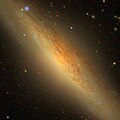| NGC 2683 | |
|---|---|
 NGC 2683, as taken by Hubble Space Telescope | |
| Observation data (J2000 epoch) | |
| Constellation | Lynx |
| Right ascension | 08h 52m 41.3s [1] |
| Declination | +33° 25′ 19″ [1] |
| Redshift | 411 ± 1 km/s [1] |
| Distance | 30.53 ± 0.91 Mly (9.36 ± 0.28 Mpc) [2] |
| Apparent magnitude (V) | 10.6 [1] |
| Characteristics | |
| Type | SA(rs)b [1] |
| Size | 122 kly (37.5 kpc) [2] |
| Apparent size (V) | 9.3′ × 2.2′ [1] |
| Other designations | |
| UGC 4641, [1] PGC 24930 [1] | |
NGC 2683 is a field spiral galaxy in the northern constellation of Lynx. It was nicknamed the "UFO Galaxy" by the Astronaut Memorial Planetarium and Observatory. [3] [4] It was discovered by the astronomer William Herschel on February 5, 1788. [5]
Contents
It is viewed nearly edge-on from Earth's location in space and is located about 30 million light-years away, [2] although previous estimates also give distances between 16 and 25 million light-years. [6]
NGC 2683 is receding from Earth at 410 km/s (250 mi/s), and from the Galactic Center at 375 km/s (233 mi/s). [3]

